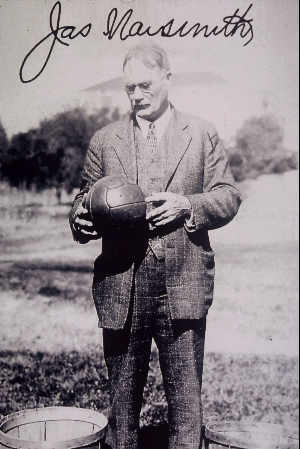The 5 Most Important Events in the History of Basketball
1) The first basketball game is played
Date: December 21, 1891
2) Basketball is first played at the Olympics
Date: August 1936
Place: Berlin, Germany
3) The formation of the NBA
Date: August 3, 1949
Place: New York City, NY
4) The first collegiate game in women's basketball history
5) A basketball game is broadcast for the first time
Date: December 21, 1891
The story behind the event: The YMCA in Springfield, Massachusetts had a class of 20 year olds that was becoming unruly during the winter when they couldn't go outside to play baseball or run track. The head of physical education at the YMCA, Dr. Luther Gulick, dared his employee, Dr. James Naismith, to invent a game for the students to play indoors. After procrastinating for most of the two weeks he was given, James Naismith invented a game with 13 rules, hung two peach baskets to an overhanging track (which just happened to be at exactly 10 feet) and the rest is the history of basketball. By the way, the game was immediately loved by his students - Dr. Naismith later said he could barely get his pupils to leave the gym when their hour had ended!
2) Basketball is first played at the Olympics
Date: August 1936
Place: Berlin, Germany
The story behind the event: You can't underestimate the importance and impact of basketball becoming an official Olympic sport, when 22 nations entered basketball teams in the XI Olympiad. In fact, the event was so important that Dr. James Naismith, then 74 years old, travelled across the Atlantic to attend. The USA beat Canada 19-8 for the gold medal, and the game was played outdoors on a tennis court, in the rain! The game's high scorer was Joe Fortenbury, with 7! By the way, women's basketball was added to the Olympics in 1976.
3) The formation of the NBA
Date: August 3, 1949
Place: New York City, NY
The story behind the event: The National Basketball League (NBL) formed in 1937, and the Basketball Association of America (BAA) formed in 1946. But the two officially combined on August 3, 1949 to form the NBA, the most important and largest group in the history of basketball. By the way, the only two teams from the initial league that have remained in the same city and under the same name are the Boston Celtics and New York Knicks.
4) The first collegiate game in women's basketball history
Date: April 4, 1896
Place: San Francisco's Page Street Armory
The story behind the event: In the most important event in womens basketball history, Stanford and Cal met in a game that did not at all resemble the fast paced and physical game the UConn and Tennessee women play today. Rules were adjusted to make sure the ladies stayed ladylike, as players were designated to one of three areas, and were not allowed to leave their area. Just trying to steal the ball from another player was against the rules! By the way, Stanford won a high scoring affair, 2-1.
5) A basketball game is broadcast for the first time
Date: February 28, 1940
Place: Madison Square Garden
The story behind the event: Fordham University played the University of Pittsburgh in the first game of a double header as Pitt won 50-37. W2XBS showed the game in New York City. Today, basketball on TV has become so popular that there's an entire network devoted to it, NBATV. By the way, only one camera was used in the first televised game in the history of basketball.
Read More......


